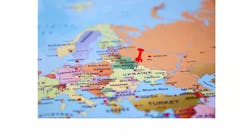Although European electrical wholesalers and manufacturers are generally pleased with this year's move from individual national currencies to the euro, they remain watchful of future business implications. Major issues include increasing price transparency and its influence on price harmonization, cross-border sourcing and the Web's role.
Overlapping banking issues are also an issue. Although each of the 12 participating countries have relinquished control of monetary policy making to the European Central Bank, which established a single interest rate for the “eurozone,” individual nations retain their own regulatory strictures for establishing a business, raising capital and monitoring internal financial matters such as pension funds.
Still, the euro is now in use by more than 300 million people in Austria, Belgium, Finland, France, Germany, Greece, Ireland, Italy, Luxembourg, the Netherlands, Portugal and Spain. The electrical industry weathered the transition with advanced preparation.
“As with companies in other industries, we instituted a special focus group representing all departments and functions within the company to determine how we would deal with the euro,” said Christof Bonn, chief executive officer of distributorship BTF and chairman of the German Electrical Wholesalers Federation. “By January of 2001, accounting and purchasing (departments) were using documentation in euros as well as marks, and price lists were showing the two prices as well. The year 2001 gave us the window of opportunity to eliminate bookkeeping errors that could have resulted in heavy financial losses due to confusion of the two currencies.”
Price HarmonizationThe greatest preoccupation in the industry remains price harmonization among the European countries; the euro has tightened the focus on this issue dramatically. If a liter of gas costs 1.05 euros in France and 0.76 euros in Spain, and a Ford Mondeo costs 26,000 euros in Finland and 19,000 euros in Spain, then it follows that there will be comparative price transparency throughout Europe for products in the electrical marketplace as well.
This is expected to be a principal driver in the industry during the first decade of the 21st century. “As the euro achieves greater visibility and integrity, this will undoubtedly lead to increased price transparency leading to an accelerated degree of price harmonization at all points in the supply chain,” said a spokesperson for one international distributorship. He added that the accessibility of pricing via the Internet, along with its ease of use and potential for cost savings, will be another powerful impetus to harmonization.
“Most of the pan-European manufacturers have been taking action to harmonize pricing over the past three years or so in anticipation of the visibility of euro pricing, which will make country-specific pricing unsustainable,” said Joe Clark of Novar, the intelligent building systems division of MK Electric Ltd. in the United Kingdom. “And the larger European wholesaling players have been seeking to leverage their scale through the development of multi-national supply agreements. But any margin benefits are likely to be short term, and the channel is unlikely to get any richer through price harmonization alone.”
In the agreement terms regarding the introduction of the Euro the European Central Bank stipulated that there could be no price increases initiated coinciding with the currency changeover. Aware of this, a number of electrical manufacturers raised prices twice in 2001 — in the spring and again in the fall. This has had an inflationary impact in a number of national markets, according to distributors.
“Prices may rise for a period until suppliers find their place in their markets,” said Gerry Kelly, of the Association of Electrical Distributors (AED) in the Republic of Ireland. “But this will be short-term (because) the market is now open to more competition without the problems of currency conversion. The increase of information readily available to every sector of the industry will facilitate the sourcing of product.”
“There can be no doubt that the multinational wholesalers will attempt to use their muscle to negotiate standard prices across Europe,” said Simon Barkes, chief executive officer of London-based distributorship BEMCO. “I cannot say how effective they have been to date, but I have no doubt that we will see more evidence of it in the future. Commodity products will be an obvious target.”
Up or Down?After this recent spate of price hikes, Yves de Coorebyter, executive director of the Belgian Electrical Wholesalers Federation and Executive Secretary of the European Union of Electrical Wholesalers (EUEW), believes prices will decrease.
“Currently, we are in a declining market, which means that prices will fall with or without the impact of the euro,” said de Coorebyter. “Within 12 months, the significant international differences in price will begin to disappear, mostly in terms of price reductions. In countries with the lowest prices, they will probably remain stable, but those are also the countries with economic difficulties, so this is hard to predict with certainty.”
Céline Bonnaire of Groupe Rexel in Paris agreed. “For the time being, we do not see any real impact of the euro on prices,” reported Bonnaire. “There may be an impact but not for the next 12 months. If it does happen, it will have a deflationary rather than an inflationary effect, largely on commodity products like cable and lighting. Any changes that will occur will probably have more to do with harmonization of regulations of European standards.”
But, the disparate nature of national economies will continue to influence price levels for some time to come, said some industry observers.
“As long as economic environments and the cost of conducting business differ from country to country, nobody can expect prices to be the same,” saud Ralf Ploenes, business development manager for distribution, Panduit Europe Ltd. “The industrial market will probably be impacted the most by the euro because of the dominance of multinational players and the non-differentiated type of products they use.”
Volume buying, as always, will be a determining factor.
“The products involved in this issue are really cross-segment and reflect where the wholesaler sees his product volume,” said Novar's Clark. “A commercial contractor may see miniature circuit-breaker prices adjust, while a lighting specialist may see volume pricing of lamps and fluorescent tubes affected.”
There is general agreement that it will be the commodity products with little or no differentiation in specifications that will be most impacted by the heightened price transparency superimposed by the euro. This leads to the question of electrical standards in Europe.
A spokesperson for a multinational distributor pointed out that one of the major reasons for price variances among countries historically has had to do with product specification differences relative to national code requirements. The euro, therefore, could be an impetus for greater efforts to achieve the long-elusive ideal of European standardization.
Cross-Border BuyingCross-border purchasing of electrical materials has been a market reality for some time in Europe. Some sources believe that the Euro will accelerate this activity, at least for the short term.
“Since last year, we have noticed a huge increase in interest by Continental buying groups regarding the Republic of Ireland,” said Kelly of AED. “The main reason for this is our participation in the euro. We believe that cross-border purchasing will increase dramatically in the future.”
BTF's Bonn anticipates the same. “We can only assume that cross-border business will increase, and we foresee more European-wide competition in our industry,” said Bonn.
Clark said that much of the cross-border purchasing takes place at the contractor and industrial-customer level, and the Euro is likely to encourage expansion of this.
One distributor source, with locations in a number of countries in the eurozone, sees this as a question of information accessing. “With the globalization of distribution and the rationalization of the marketplace, distributors will be sharing more information, and this makes pricing data easier to acquire,” he said. “Technology — the Internet in particular — allows purchasing agents to migrate to the lowest cost zones. The end-user customer, in most cases, is leading the move toward price harmonization, while the manufacturer is anxious to preserve differentiation.”
Over the medium term, one manufacturer spokesperson speculates, the eurozone will expand beyond the 12 nations now involved, and this will accelerate activity in all of the areas already discussed. “But the customer remains the key,” he said. “Whether he buys with francs or marks or euros, the fundamentals of the marketplace will not change. We will see a new level of competition due to the euro and the Internet. This constitutes a greater threat than ever to complacent businesses that do not understand the customer's needs.”
The author is a freelance communications consultant based in Stamford, Conn. He can be telephoned at (203) 323-9850 or e-mail him at [email protected].









